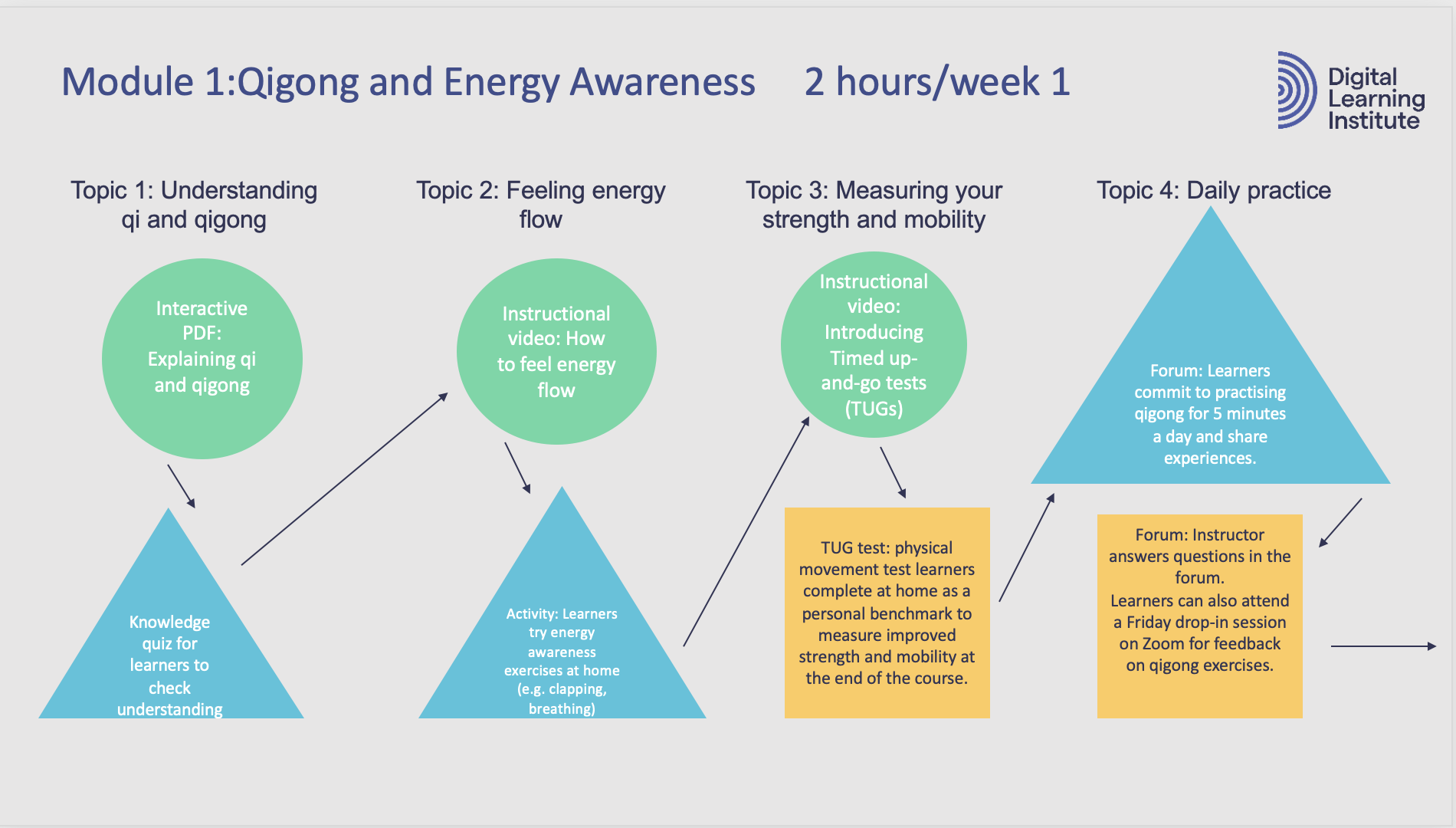Tai Chi and Qigong for Health
Overview
Project description: I designed this online course for a tai chi instructor and developed a working prototype of the first lesson. The project also formed part of my assessment for my Diploma in Digital Learning Design.
Sector: Health and Wellness
Audience: Women aged 50-70 who want to practise tai chi and qigong to improve their health and mobility.
Tools used:
· Genially (for the prototype – an interactive PDF)
· Microsoft Word, Padlet and Zoom (for collaboration and planning)
Challenge: My client quickly moved her face-to-face classes to Zoom during lockdown. Although she is now teaching in the community again, she wants to continue to offer an online option to improve accessibility and flexibility. Her target audience spans a wide age group with varying levels of health, mobility and digital literacy.
Design process
Learner personas
Based on data provided by my client, I created two learner personas for the project. Because of the age range covered, one persona is based on a learner who is retired and the other on a learner who is still in the workforce. Learners who are currently employed tend to have had more exposure to online learning through workplace compliance courses. As a result, they usually have higher levels of digital literacy.


Key design considerations:
Based on the learner personas, this course needs to:
include user-friendly formats with clear instructions to help learners access and navigate the content.
be available on multiple devices and on both IOS and Windows operating systems.
include social learning components.
allow easy access to the instructor for support and feedback.
be broken down into short, manageable learning chunks.
The WHY of Learning
Next, I worked with the client to identify her students’ skill and knowledge gaps. We drafted learning outcomes for the course using Bloom’s Taxonomy and SMART goals. As the learners have different health and fitness levels, we had to ensure the learning outcomes measured personal improvement rather than aiming for a particular level of strength and mobility.
Click here to read more about the planning for this stage.
Mapping out the course
We mapped out the modules and topics together using the client’s pre-existing content. Tai Chi and Qigong for Health and Mobility follows in a linear, synchronous pattern with 5 modules introduced over 5 weeks.
Course plan for Week 1
Virtual classrooms are used in Modules 3-5 to introduce the 10 tai chi movements. Qigong, which focuses on breathing and mediative techniques, is introduced in Modules 1-2. The client advised me that qigong does not need to be introduced in a virtual classroom and can be covered in articles and instructional videos.
Restricting the number of online classes also makes the course more accessible to those who are time poor or face health conditions that affect their energy levels.
Click here to view the full course plan.
Key course features:
· A range of multimedia formats to add variety and cater to different learning preferences.
· Social learning components through virtual classrooms and discussion forums.
· Podcast interviews with health professionals and links to research articles for a deeper dive into the content.
· Daily practice at the end of each module for knowledge consolidation, habit-building and learning experience consistency.
Scoping Plan and Wireframe
Wireframe for interactive PDF
For my diploma, I had to plan and develop a working prototype for one component of the online course.
I chose to design an interactive PDF for the first lesson.
Understanding Qi and Qigong is a content-based lesson, providing background information before learners move onto qigong and tai chi exercises through videos and virtual classrooms later in the course.
The client provided me with the lesson content and two science-based articles that I could use as additional resources.
Using this content, I developed two micro learning outcomes for the interactive PDF that were linked to the macro learning outcomes for the course.
It was important to divide the client’s content into shorter learning chunks, so it was more suitable for an online format. I split it into 2 sections (Qi and Qigong) with 3 topics under each section.
Screenplan and Storyboard
The next stage was a screenplan and storyboard. While designing these, I referred to the C.RA.P. Principles for Visual Design and Mayer’s Principles of Multimedia Learning to create the best possible learning experience for the students. Most of the storyboard is text-based, but I have provided mock-ups for some of the screens to bring it to life.
Page 2 of the storyboard
Click here to view the full storyboard.
Prototype
I produced a working prototype of the interactive PDF using Genially. During this development phase, I added interactive elements to each page such as navigation buttons, hyperlinks to external sources and clickable images with further information attached. Click here to view the prototype.
Key features of the interactive PDF
Accessible colour palette representing the client’s brand colours.
Sources Sans Pro font for easy online readability.
Alternative text for images for screen reader accessibility.
Clear navigation instructions for all learners.
Mobile-friendly learning experience.
Reflections
This project gave me the opportunity to collaborate with a Subject Matter Expert and put instructional design principles into practice while learning new tools. Above all, it gave me valuable insights into the key challenges and considerations at each stage of the learning design process. These have helped me grow professionally and I look forward to applying what I’ve learnt in my next project.



